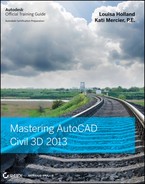Chapter 6
Alignments
Some roads were laid out hundreds of years ago by herds of cows; others were microdesigned by planners with careful consideration for each bend and twist. Either way, when working on a linear project, whether it be the renovation of an old New England cow path or a network of new subdivision roads, horizontal layout information will need to be conveyed to the contractor. This horizontal layout is the alignment and drives much of the design. This chapter shows you how alignments can be created, how they interact with the rest of the design, how to edit and analyze them, and finally, how they work with the overall project.
In this chapter, you will learn to:
- Create an alignment from an object
- Create a reverse curve that never loses tangency
- Replace a component of an alignment with another component type
- Create alignment tables
Alignment Concepts
Before you can efficiently work with alignments, you must understand two major concepts: the interaction of alignments and sites, and the idea of geometry that is fixed, floating, or free.
Alignments and Sites
Prior to the AutoCAD® Civil 3D® 2008 release, alignments were always a part of a site and interacted with the topology contained in that site. This interaction led to the pickle analogy: alignments are like pickles in a Mason jar. You don't put pickles and peppers in the same jar unless you want hot pickles, and you don't put lots and alignments in the same site unless you want subdivided lots.
Civil 3D now has two ways of handling alignments in terms of sites: they can be contained in a site as before, or they can be independent of a site.
Both the alignments contained in a site and those independent of a site can be used to cut profiles or control corridors, but only the alignments contained in a site will react with and create parcels as members of a site topology.
Unless you have good reason for them to interact (as in the case of an intersection), it makes sense to create alignments outside of any site object. They can be moved later if necessary. For the purpose of the exercises in this chapter, you won't place any alignments in a site.
Alignment Entities
Civil 3D recognizes five types of alignments: centerline alignments, offset alignments, curb return alignments, rail alignments, and miscellaneous alignments. Each alignment type can consist of three types of entities or segments: lines, arcs, and spirals. These segments control the horizontal alignment of your design. Their relationship to one another is described by the following terminology:
Fixed Segments
Fixed segments are fixed in space (see Figure 6.1). They're defined by connecting points in the coordinate plane and are independent of the segments that occur either before or after them in the alignment. Fixed segments may be created as tangent to other components, but their independence from those objects lets you move them out of tangency during editing operations.
Floating Segments
Floating segments float in space but are attached to a point in the plane and to some segment to which they maintain tangency (see Figure 6.2). Floating segments work well in situations where you have a critical point but the other points of the horizontal alignment are flexible.
Free Segments
Free segments are functions of the entities that come before and after them in the alignment structure (see Figure 6.3). Unlike fixed or floating segments, a free segment must have segments that come before and after it. Free segments maintain tangency to the segments that come before and after them and move as required to make that happen. Although some geometry constraints can be put in place, these constraints can be edited and are user dependent.
During the exercises in this chapter, you'll use a mix of these entity types to understand them better.
Creating an Alignment

Alignments can be created from AutoCAD objects (lines, arcs, or polylines) or by layout. This section looks at both ways to create an alignment and discusses the advantages and disadvantages of each. The exercise will use the street layout shown in Figure 6.4 as well as the different methods to achieve your designs.
Creating from a Line, Arc, or Polyline
Most designers have used either polylines or lines and arcs to generate the horizontal control of their projects. It's common for surveyors to generate polylines to describe the center of a right-of-way or for an environmental engineer to draw a polyline to show where a new channel should be constructed. These team members may or may not have Civil 3D software, so they use their familiar friends — the line, arc, and polyline — to describe their design intent.
Although these objects are good at showing where something should go, they don't have much data behind them. To make full use of these objects, you should convert them to native Civil 3D alignments that can then be shared and used for myriad purposes. Once an alignment has been created from a polyline, offsets can be created to represent rights of way, building lines, and so on. In this exercise, you'll convert a polyline to an alignment and create offsets:
1. Open the AlignmentsFromPolylines.dwg file (or for metric users, the AlignmentsFromPolylines_METRIC.dwg file).
You can download this file from the book's web page at
www.sybex.com/go/masteringcivil3d2013. You will see the red polylines representing the centers of roads, rights-of-way, and parcels.

2. From the Home tab ⇒ Create Design panel, choose Alignment ⇒ Create Alignment From Objects.
3. Pick the two lines and arc labeled Syrah Way, shown previously in
Figure 6.4, and press

.
4. Verify that the direction is from left to right and press

.
The Create Alignment From Objects dialog appears.
5. Change the Name field to
Syrah Way, and select the Centerline type, as shown in
Figure 6.5.
6. Verify that Alignment Style is set to Proposed and Alignment Label Set is set to Major And Minor Only.
7. Accept the other settings, and click OK.
A Word About Constraints
In previous versions, creating from objects held no constraints (everything was fixed). In current versions, Civil 3D tries to find tangency associates if a curve is between two lines. Lines will always be Not Constrained (Fixed), but if the curve is tangent it will be Constrained On Both Sides (Free).
Keep this drawing open for the next portion of the exercise.
The Create Alignment From Objects Dialog
In the Create Alignment From Objects dialog (shown in
Figure 6.5), there are many settings that you can adjust when creating an alignment:
Name
This is the alignment name. No alignment name can be duplicated in a drawing.
Type
The alignment types can be thought of as places for objects that are alike. They can react differently depending on which type is selected.
Centerline
Used mainly for centers of roads, streams, or swales. Civil 3D places this type of alignment in the Alignments ⇒ Centerline Alignments collection.
Offset
Used for offset alignments. The difference between this and the centerline alignment is that you have the option in the Alignment Properties dialog to set Offset parameters, such as naming a parent alignment and offset values. Civil 3D places this type of alignment in the Alignments ⇒ Offset Alignments collection.
Curb Return
Used for curb returns, which are the radii at intersections. The difference between this and the offset alignment is that instead of offset, you have the option in the Alignment Properties dialog to set Curb Return parameters, such as setting two parent alignments and offsets. Civil 3D places this type of alignment in the Alignments ⇒ Curb Return Alignments collection.
Rail
Used for rails. The difference between this and the other alignments is that the alignment is set using typical rail geometry such as degree of curvature and cant. In addition, a unique tab is added to the Alignment Properties dialog called Rail Parameters, where you can specify the Track Width. Civil 3D places this alignment type in the Alignments ⇒ Rail Alignments collection.
Miscellaneous
This is a stripped-down alignment type that only contains Information, Stationing, Masking, Point Of Intersection, and Constraint Editing tabs. Civil 3D places this alignment type in the Alignments ⇒ Miscellaneous Alignments collection.
Description
An optional field where you can be as verbose as you want with information describing your alignment.
Starting Station
Setting this with a number, either positive or negative, will be the starting stationing for the alignment. This is handy if you need to start your alignment to coincide with existing stationing, or if you wish to have your 0+00 stationing at an intersection of a road. If you forget to set this value here, you can change it later in the Alignment Properties dialog.
The General tab contains the following options:
Site
A place to keep Civil 3D objects that you want to interact with each other. As previously mentioned, all of your alignments in these exercises will be put on the <None> site.
Alignment Style
You can set different styles to visually show your alignment. For more on styles, refer to Chapter 21, “Object Styles.”
Alignment Layer
Overrides the layer that is specified in the Drawing Settings for alignments.
Alignment Label Set
As with the Alignment Style, you can choose how your alignment will be labeled. For more on label styles, refer to Chapter 20, “Label Styles.”
Conversion Options
Depending on your selections, these will add curves or erase the original entities.
The Design Criteria tab contains these options:
Starting Design Speed
Specify the design speed of the alignment for the starting station. If no additional design speeds are applied to a different section of the alignment, this speed will be used for the entire alignment.
Use Criteria-Based Design
When this check box is selected, the Use Design Criteria File and Use Design Check Set options can be used.
Use Design Criteria File
Here you can define the design criteria, such as the American Association of State Highway and Transportation Officials (AASHTO) A Policy on Geometric Design of Highways and Streets, 2001 design manual.
Use Design Check Set
Here you can set rules, or expressions for lines, curves, spirals, and tangent intersections.
Many of these settings will be discussed further throughout this chapter.
You've created your first alignment and attached stationing and geometry point labels. It is common to create offset alignments from a centerline alignment to begin to model rights-of-way. In the following exercise, you'll create offset alignments and mask them where you don't want them to be seen:

1. Using the drawing from the previous exercise, from the Home tab ⇒ Create Design panel, choose Alignment ⇒ Create Offset Alignment.
2. Pick the Syrah Way alignment to open the Create Offset Alignments dialog shown in
Figure 6.6.
3. Change Incremental Offset On The Left to 25′ (metric users, 7.5).
4. Change Incremental Offset On The Right to 25′ (metric users, 7.5).
5. Verify that Alignment Label Set is set to _No Labels, and click OK to accept the rest of the defaults shown in
Figure 6.6.
6. Select the offset alignment just created along the northerly right-of-way of Syrah Way to activate the contextual tab.
7. From the contextual tab ⇒ Modify panel, choose Alignment Properties to open the Alignment Properties dialog.

8. Change to the Masking tab and click the Add Masking Region button.
9. Enter 0 for the first station and 50 for the second station when prompted (metric users, enter 0 and 15), and click OK.
Notice that the alignment is now masked at the intersection of Syrah Way and Frontenac Drive at the east end.
10. Repeat the process for the rest of the intersections, starting at the end of the arc on both right-of-way alignments on Syrah Way.

While you entered the information using text in the previous step, notice that you could alternatively use the station picker button, which becomes visible when you click into the cell to enter a value.
Once complete, the Masking tab of the Alignment Properties dialog should look like
Figure 6.7.
When this exercise is complete, you may close the drawing. A saved finished copy of this drawing is available from the book's web page with the filename AlignmentsFromPolylines_FINISHED.dwg or AlignmentsFromPolylines_METRIC_FINISHED.dwg. Note that when you selected the beginning and end of the offset alignment, the Lock To Start and Lock To End boxes were checked automatically.
Offset alignments are simple to create, and they are dynamically linked to a centerline alignment. To test this, grip the centerline alignment, select the endpoint grip, and stretch the alignment to the west. Notice the change, and then undo this change to return to the original state.
Offset Grips and More
Offset alignments have two special grips: the arrow and the plus sign. The arrow is used to change the offset value, and the plus sign is used to create a transition, called a widening, such as a turning lane. To access the Create Widening command, from the Home tab ⇒ Create Design panel, select the Alignment drop-down. Widening criteria can also be found in the Create Offset Alignments dialog.
Even offset alignments with widening remain dynamic to their host alignment. Offset alignment objects can be found in Prospector in the Alignments collection.
You created an alignment from polylines and two offsets. It's ready for use in corridors, in profiling, or for any number of other uses.
Creating by Layout
Now that you've made an alignment from polylines, let's look at another creation option: Create By Layout. You'll use the same street layout (Figure 6.4) that was provided by a planner, but instead of converting from polylines, you'll trace the alignments. Although this seems like duplicate work, it will pay dividends in the relationships created between segments:
1. Open the AlignmentsByLayout.dwg or the AlignmentsByLayout_METRIC.dwg file.

2. From the Home tab ⇒ Create Design panel, choose Alignment ⇒ Alignment Creation Tools.
The Create Alignment–Layout dialog appears.
3. Change the Name field to Cabernet Court if it is not already set.
4. Verify that Alignment Style is set to Proposed and Alignment Label Set is set to Major And Minor Only.
5. Click OK to accept the other settings shown in
Figure 6.8.
The Alignment Layout Tools toolbar for Cabernet Court appears (
Figure 6.9).
6. Click the down arrow next to the Tangent-Tangent (No Curves) tool at the far left, and select the Tangent-Tangent (With Curves) option (see
Figure 6.10).
The tool places a curve automatically; you'll later adjust the curve, watching the tangents extend as needed.
7. Turn on the Endpoint Osnap and snap to the southernmost end of the Cabernet Court centerline.
8. Continue to pick the endpoints of the red lines to finish creating this alignment.
9. Press

to end the command.
10. Click the X button at the upper-right on the Alignment Layout Tools toolbar for Cabernet Court to close it.
Keep this drawing open for the next portion of the exercise.
Zoom in on the southern arc. Notice that it follows closely with the desired arc radius. Now zoom in on the northern arc, and notice that it doesn't match the arc the planner put in for you to follow. That's okay — you will fix it in a later exercise.
Design and Then Refine
It bears repeating that in dealing with Civil 3D objects, it is good practice to get something in place and then refine. With Land Desktop or other packages, you didn't want to define the object until it was fully designed. In Civil 3D, you design and then refine.
The alignment you just made is one of the most basic. Let's move on to some of the others and use a few of the other tools to complete your initial layout. In this exercise, you build the alignment at the north end of the site, but this time you use a floating curve to make sure the two segments you create maintain their relationship:
11. From the Home tab ⇒ Create Design panel, choose Alignment ⇒ Alignment Creation Tools.
The Create Alignment – Layout dialog appears.
12. In the Create Alignment – Layout dialog, do the following:
A. Change the Name field to Frontenac Drive.
B. Set the Alignment Style field to Layout.
C. Set the Alignment Label Set field to Major And Minor Only.
13. Click OK to display the Alignment Layout Tools toolbar for Frontenac Drive.
14. Select the Fixed Line (Two Points) tool, as shown in
Figure 6.11.
15. Using Endpoint Osnaps, select the eastern end of Frontenac Drive and, working south to north, draw the first fixed-line segment to the starting endpoint of the cyan arc.
When you've finished, the command line will read
Specify start point: in case you want to draw another line. You can either press

to end the command or draw the next entity without ending the command.
16. Click the down arrow next to the Add Fixed Curve (Three Point) tool on the toolbar, and select More Floating Curves ⇒ Floating Curve (From Entity End, Through Point), as shown in
Figure 6.12.
17. Select the fixed-line segment you drew in steps 14 and 15.
Make sure you select the line segment somewhere north of the segment's midpoint in order to connect to the northern endpoint instead of the southern endpoint.
Move your cursor around and a blue rubber band should appear, indicating that the alignment of the curve segment is being floated off the endpoint of the fixed segment.
18. Pick the endpoint of the arc of the Frontenac Drive polyline arc segment.
Notice that you are generating the segments from low station to high station. If you perform these steps backward, you can reverse a segment using the Reverse Sub-Entity Direction button on the Alignment Layout Tools toolbar.
19. Right-click or press

to end the command.
20. Close the Alignment Layout Tools toolbar.
21. Pick the Frontenac Drive alignment and then pick the grip on the upper end of the line and pull it away from its location.
Notice that the line and the arc move in sync and tangency is maintained (see
Figure 6.13).
22. Press Esc to cancel the grip edit.
When this exercise is complete, you may close the drawing. A saved finished copy of this drawing is available from the book's web page with the filename AlignmentsByLayout_FINISHED.dwg or AlignmentsByLayout_METRIC_FINISHED.dwg.
All Aboard! Rail Alignments
New to Civil 3D 2013 are rail alignments. Since railways often have very large sweeping curves, the alignments are often defined slightly differently than typical roadway alignments. Instead of radii, railway plans often refer to the degree of curvature, and rather than defining the curve by length, Civil 3D 2013 defines the curve by chords. This terminology, which is common in the rail world, is included in the alignment components. Let's look at a quick, simple example:
1. Start a new blank drawing from the _AutoCAD Civil 3D (Imperial) NCS template that ships with Civil 3D. Metric users should use the _AutoCAD Civil 3D (Metric) NCS template.
2. From the Home tab ⇒ Create Design panel, choose Alignment ⇒ Alignment Creation.
The Create Alignment – Layout dialog appears.
3. Change the Name to Mastering Railway and set Type to Rail.
4. On the General tab, make these changes:
- Set Alignment Style to Proposed.
- Set Alignment Label Set to All Labels.
5. Switch to the Design Criteria tab.
6. Change the starting design speed to 30 mi/hr (or 50 km/hr for metric users).
7. Select the Use Criteria-Based Design check box.
If the Design Criteria File doesn't default to the Railway Design Standards, you may need to click the ellipsis next to the design criteria file to browse to _Autodesk Civil 3D Imperial Rail Cant Design Standards.xml or _Autodesk Civil 3D Metric Rail Cant Design Standards.xml.
8. Verify that Use Design Criteria File is also checked.
9. Click OK.
The Alignment Layout Tools toolbar appears.
10. Select the Fixed Line (Two Points) tool.
11. Click anywhere on the screen to define the start point and define the second point by entering @330,0 on the command line (or @100,0 for metric users).
12. Press

to end the command.
13. Select Floating Curve (From Entity End, Radius, Length).
14. At the Select entity to attach to: prompt, select the line segment that you just drew.
15. At the
Specify curve direction [Clockwise cOunterclockwise] <Clockwise>: prompt, press

to accept the default, Clockwise.
16. At the
Specify radius or [Degree of curvature]: prompt, enter
D 
to switch to entering the radius by degree of curvature.
17. At the
Specify degree of curvature or [Radius]: prompt, enter
3 
.
18. At the
Specify curve length or [deltaAngle Tanlen Chordlen midOrd External]: prompt, enter
C 
to define by chord length (which is common in rail alignments).
19. At the
Specify chord length or [curveLen deltaAngle Tanlen midOrd External]: prompt, enter
100 
.
20. Press

to end the command.
Note that this will result in a different curve for Imperial and metric users.
When this exercise is complete, you may close the drawing. A saved finished copy of this drawing is available from the book's web page with the filename Rail_FINISHED.dwg or Rail_METRIC_FINISHED.dwg.
Best Fit Alignments
Often designers have to re-create an alignment for an existing road that does not have true horizontal geometry. Civil 3D has multiple tools to re-create the alignment using a best fit algorithm. You can either re-create a full best fit alignment or use best fit lines or best fit curves in an alignment. We will look at both methodologies in this section.
The Create Best Fit Alignment command can use AutoCAD blocks, entities, points, COGO points, or feature lines. You can also simply click on the screen. The Line and Curve drop-down menus on the Alignment Layout toolbar include options for Floating and Fixed Lines By Best Fit, as well as Best Fit curves in all three flavors: Fixed, Float, and Free. It is similar to what we covered in Chapter 1, “The Basics,” in the “Best Fit Entities” section. Let's see how it works with alignments:
1. Open the AlignmentsBestFit.dwg or AlignmentsBestFit_METRIC.dwg file, which you can download from this book's web page.
2. From the Home tab ⇒ Create Design panel, choose Alignment ⇒ Alignment Creation Tools.
The Create Alignment – Layout dialog appears.
3. Enter Best Fit Lines in the Name field.
4. Leave the rest at their defaults and click OK.
The Alignment Layout Tools – Best Fit Lines palette opens.
5. Click the down arrow next to the Fixed Line (Two Points) tool on the toolbar, and select the Fixed Line – Best Fit option.
Here, you can choose various methods to create a best fit line alignment:
- From COGO Points
- From Entities
- From AutoCAD Points
- By Clicking On The Screen
6. Pick the By Clicking On The Screen radio button and click OK.
7. With the running Endpoint Osnap, click on all the endpoints of the polyline.
As you progress, you see a red dashed line being formed. In your selections, this line looks at all the endpoints selected in order to create the best fit line alignment (
Figure 6.15).
8. When you get to the last endpoint, press

to open the Regression Data vista.
9. In the Regression Data vista, you can choose to exclude endpoints or force them to be a pass-through endpoint by checking the appropriate boxes (
Figure 6.16).
As you do, notice the changes that occur on your best fit line alignment.
10. Click the green check mark on the upper-right side of the Regression Data vista to accept and dismiss the Panorama window.
The best fit line alignment is complete. You can also create a similar command for a best fit curve sub-entity that can be either fixed or floating. The procedure is similar to that of the best fit line and can be performed on the polyline that vaguely resembles a curve in the exercise drawing.
Keep this drawing open for the next portion of the exercise.
One of the benefits to doing individual best fit segments (lines or curves) is that it is easy to exclude points. However, sometimes you will want a single “rough and dirty” alignment full of curves and lines without having to define them individually. Next you will create a full best fit alignment.
11. Zoom and pan to the area with the 13 points.

12. From the Home tab ⇒ Create Design panel, choose Alignment ⇒ Create Best Fit Alignment. The Create Best Fit Alignment dialog appears.
13. Set the input type to AutoCAD Points and click the Selection button next to Path 1 Points.
14. In modelspace, use a crossing window to select the 13 points and press

.
15. Deselect the Create Spirals check box.
16. Change the name to Best Fit Alignment.
17. Verify that the Alignment style is set to Layout and the Alignment label set is set to _No Labels, as shown in
Figure 6.17, and click OK to accept all the other defaults.
The Best Fit Report dialog opens, as shown in
Figure 6.18.
Review the results in the Best Fit Report. Notice that if you select a row it will zoom to the location on the regression graph.
18. Click the close X button to dismiss the dialog.
Unlike the Regression Data vista in the Panorama window, the Best Fit Report is purely informational and does not allow you to select to exclude or pass through a specific point. While the Create Best Fit Alignment procedure is fast, it may not be precise. Therefore, this command may be useful for providing a draft alignment and then manually creating your final alignment using similar results to those shown in the Best Fit Report that meet your specific design criteria.
The completed best fit alignment is shown in Figure 6.19. Although a best fit alignment may not give you exactly what you are looking for (especially if you like nice, whole-number radii), it generates a good starting point that you can then edit to fit your design needs.
When this exercise is complete, you may close the drawing. A saved finished copy of this drawing is available from the book's web page with the filename AlignmentsBestFit_FINISHED.dwg or AlignmentsBestFit_METRIC_FINISHED.dwg.
Reverse Curve Creation
Next, let's look at a more complicated alignment construction — building a reverse curve connecting two curves:
1. Open the AlignmentReverse.dwg or AlignmentReverse_METRIC.dwg file.
2. For this exercise, confirm that your Endpoint Osnap is activated and the other Osnaps can be deactivated.
3. From the Home tab ⇒ Create Design panel, choose Alignment ⇒ Alignment Creation Tools.
The Create Alignment – Layout dialog appears.
4. In the Create Alignment – Layout dialog, do the following:
A. Change the Name field to Reverse.
B. Set the Alignment Style field to Layout.
C. Set the Alignment Label Set field to Major Minor And Geometry Points.
5. Click OK to display the Alignment Layout Tools toolbar for the reverse alignment.
6. Start by drawing a fixed line from the north end of the western portion to its endpoint using the same Fixed Line (Two Points) tool as used in an earlier exercise.
7. Use the Floating Curve (From Entity, Radius, Through Point) tool to connect a curve from the southern end of this segment.
8. At the
Specify radius: prompt, enter
500 
(for metric,
150 
).
9. At the
Is curve solution angle [Greaterthan180 Lessthan180] <Lessthan180>: prompt, press

to accept the default.
10. At the Specify end point: prompt, click on the other end of the arc.
11. The command repeats; at the Select entity to attach to: prompt, select the curve that you just created.
12. At the
Specify radius or [Degree of curvature]: prompt, enter
400 
(for metric,
120 
).
13. At the
Is curve solution angle [Greaterthan180 Lessthan180] <Lessthan180>: prompt, press

to accept the default.
14. The program detects that you are attaching a curve to a curve; at the
Is curve compound or reverse to curve before? [Compound Reverse] <Compound>: prompt, enter
R 
to specify that it is a reverse curve.
15. At the Specify end point: prompt, click the endpoint of the southern arc.
16. Press

to end the command.
17. Use the Floating Line (From Curve, Through Point) tool to connect a line from the second curve and to finish the alignment by selecting the two-point line (
Figure 6.20).
The alignment now contains a perfect reverse curve. Move any of the pieces, and you'll see the other segments react to maintain the relationships shown in Figure 6.21. The flexibility of the Civil 3D tools allows you to explore an alternative solution (the reverse curve) as opposed to the basic solution. Flexibility is one of the strengths of Civil 3D.
You've completed your initial reverse curve layout. Unfortunately the reverse curve may not be acceptable to the designer, but you'll look at those changes later in the section “Component-Level Editing.”
When this exercise is complete, you may close the drawing. A saved finished copy of this drawing is available from the book's web page with the filename AlignmentReverse_FINISHED.dwg or AlignmentReverse_METRIC_FINISHED.dwg.
Creating with Design Constraints and Check Sets
Starting in Civil 3D 2009, users have the ability to create and use design constraints and design check sets during the process of aligning and creating design profiles. Typically, these constraints check for things like curve radius, length of tangents, and so on. Design constraints use information from AASHTO or other design manuals to set curve requirements. Check sets allow users to create their own criteria to match local requirements, such as subdivision or county road design. First, you'll make one quick set of design checks:
1. Open the CreatingChecks.dwg or CreatingChecks _METRIC.dwg file.
2. On the Settings tab in Toolspace, expand the Alignment ⇒ Design Checks branch.
3. Right-click the Line folder, and select New to display the New Design Check dialog.
4. Change the name to Subdivision Tangent.

5. Click the Insert Property drop-down menu, and select Length.
6. Click the greater-than/equals symbol (>=) button, and then enter 100 (for metric, 30) in the Expression field as shown.
When complete, your dialog should look like
Figure 6.22. Click OK to accept the settings in the dialog.
7. Right-click the Curve folder, and select New to display the New Design Check dialog.
8. Change the name to Subdivision Radius.
9. Click the Insert Property drop-down menu, and select Radius.
10. Click the greater-than/equals symbol (>=) button, and then enter
200 (for metric,
60) in the Expression field, as shown in
Figure 6.23.
11. Click OK to accept the settings in the dialog.
12. Right-click the Design Check Sets folder, and select New to display the Alignment Design Check Set dialog.
13. On the Information tab, change the name to Mastering Subdivision, and then switch to the Design Checks tab.
14. Choose Line from the Type drop-down list and select the Subdivision Tangent line check that you just created.
15. Click the Add button to add the Subdivision Tangent check to the set.
16. Choose Curve from the Type drop-down list and select the Subdivision Radius curve check that you just created.
17. Click the Add button again to complete the set, as shown in
Figure 6.24.
18. Click OK to accept the settings in the dialog.
You may keep this drawing open to continue to the next exercise or use the saved finished copy of this drawing available from the book's web page (CreatingChecks_FINISHED.dwg or CreatingChecks_METRIC_FINISHED.dwg).
Once you've created a number of design checks and design check sets, you can apply them as needed during the design and layout stage of your projects.
Design Checks vs. Design Criteria
In typical fashion, the language used for this feature isn't clear. What's the difference? A design check uses basic properties such as radius, length, grade, and so on to check a particular portion of an alignment or profile. These constraints are generally dictated by a governing agency based on the type of road involved. Design criteria use speed and related values from design manuals such as AASHTO to establish these geometry constraints. Think of design criteria as a suite of check sets with different sets for each city, type of street, design speed, and so on.
In the next exercise, you'll see the results of your Mastering Subdivision check set in action:
1. If not still open from the previous exercise, open the CreatingChecks_FINISHED.dwg or CreatingChecks_METRIC_FINISHED.dwg file.
2. Change to the Prospector tab in Toolspace, and expand the Alignments ⇒ Centerline Alignments branch.
3. Right-click on Frontenac Drive and select Properties.
4. Change to the Design Criteria tab, and set the start station design speed to
30 mi/h (or
50 km/h), as shown in
Figure 6.25.
5. Verify that all of the check boxes are selected and that Design Check Set is set to Mastering Subdivision.
Note that the Use Criteria-Based Design check box must be selected to activate the other two.
6. Click OK to accept the settings in the dialog.
You could have alternatively set the design criteria when you were originally creating the alignment.
The curve radius on the northernmost part of Frontenac Drive is less than the Subdivision Radius design check, as illustrated by the design check failure indicators.
7. In Prospector, right-click on the alignment named Frontenac Drive and select the Select option to activate the Alignment contextual tab.
8. From the contextual tab ⇒ Modify panel, choose Geometry Editor to display the Alignment Layout Tools toolbar.
9. Select the Tangent-Tangent With Curves option on the left side of the Alignment Layout Tools toolbar.
10. Starting at the end of the northeastern Frontenac Drive curve, connect the endpoints of the tangent lines to finish creating the Frontenac Drive alignment.
Notice that the two curves generated do not match the ones that the planner had originally laid out; you will fix them in the next exercise.
If you hover over the exclamation-point symbol, as shown in
Figure 6.26, it will indicate which design criteria and design checks have been violated.
11. Close the Alignment Layout Tools toolbar.
When this exercise is complete, you may close the drawing. A saved finished copy of this drawing is available from the book's web page with the filename AlignmentsChecked_FINISHED.dwg or AlignmentsChecked_METRIC_FINISHED.dwg.
Now that you know how to create an alignment that doesn't pass the design checks, let's look at different ways of modifying alignment geometry. As you correct and fix alignments that violate the assigned design checks, those symbols will disappear.
Editing Alignment Geometry
The general power of Civil 3D lies in its flexibility. The documentation process is tied directly to the objects involved, so making edits to those objects doesn't create hours of work in updating the documentation. With alignments, there are three major ways to edit the object's horizontal geometry without modifying the underlying construction:
Graphical Grip Editing
Select the object, and use the various grips to move critical points. This method works well for realignment, but precise editing for things like a radius or direction can be difficult without construction elements.
Tabular Design
Use Panorama to view all the alignment segments and their properties; type in values to make changes. This approach works well for modifying lengths or radius values, but setting a tangent perpendicular to a screen element or placing a control point in a specific location is better done graphically.
Component-Level Editing
Use the Alignment Layout Parameters dialog to view the properties of an individual piece of the alignment. This method makes it easy to modify one piece of an alignment that is complicated and that consists of numerous segments, whereas picking the correct field in a Panorama view can be difficult.
In addition to these methods, you can use the Alignment Layout Tools toolbar to make edits that involve removing components or adding to the underlying component count. The following exercises look at the three simple edits and then explain how to remove components from and add them to an alignment without redefining it.
Grip Editing
You already used graphical editing techniques when you created alignments from polylines, but those techniques can also be used with considerably more precision than shown previously. The alignment object has a number of grips that reveal important information about the elements' creation (see Figure 6.27).
You can use the grips in Figure 6.27 to do the following actions:
- The square pass-through grip at the beginning of the alignment, Grip 1, indicates a segment point that can be moved at will to change the length and angle of the line. This grip doesn't attach to any other components.
- The square pass-through grip in the middle of the tangents, Grip 2, allows the element to be translated while maintaining the length and angle. Other components attempt to hold their respective relationships, but moving the grip to a location that would break the alignment isn't allowed.
- The triangular grip at the intersection of tangents, Grip 3, indicates a Point of Intersection (PI) relationship. The curve shown is a function of these two tangents and is free to move on the basis of incoming and outgoing tangents, while still holding a radius.
- The triangular and circular radius grips near the middle of the curve, Grip 4, allow the user to modify the radius directly. The tangents must be maintained, so any selection that would break the alignment geometry isn't allowed.
- The circular pass-through grip on the end of the curve, Grip 5, allows the radius of the curve to be indirectly changed by changing the point of the Point of Curvature (PC) of the alignment. You make this change by changing the curve length, which in effect changes the radius.
In the following exercise, you'll use grip edits to make one of your alignments match the planner's intent more closely:
1. Open the AlignmentsChecked_FINISHED.dwg or AlignmentsChecked_METRIC_FINISHED.dwg file.
2. In Prospector, expand the Alignments ⇒ Centerline Alignments branch.
3. Right-click on Cabernet Court and select Zoom To.
4. Zoom in on the northern curve of the Cabernet Court alignment.
This curve was inserted in a previous exercise using the default settings and doesn't match the guiding polyline well.
5. Select the Cabernet Court alignment to activate the grips.
6. Select the circular grip shown in
Figure 6.28, and use an Endpoint Osnap to place it on the original cyan arc. Doing so changes the radius without changing the PI.
Keep this drawing open for the next portion of the exercise.
Your alignment of Cabernet Court now follows the planned layout. With no knowledge of the curve properties or other driving information, you've quickly reproduced the design's intent.
Tabular Design
When you're designing on the basis of governing requirements, one of the most important elements is meeting curve radius requirements. It's easy to work along an alignment in a tabular view, verifying that the design meets the criteria. In this exercise, you'll verify that your curves are suitable for the design:
1. Using the drawing from the previous exercise, zoom to the Frontenac Drive alignment, and select it to activate the contextual tab.
2. From the Alignment contextual tab ⇒ Modify panel, choose Geometry Editor.
The Alignment Layout Tools toolbar opens.

3. Select the Alignment Grid View tool.
Panorama appears as shown in
Figure 6.29, with all the elements of the alignment listed along the left. You can use the scroll bar along the bottom to review the properties of the alignment if necessary. Note that the columns can be resized as well as toggled off by right-clicking the column headers. The segment selected in the alignment grid view is also highlighted in the model, which can also make identifying the segment easier. Note that the design check failure indicators that are shown on the plan also appear in the table.
Creating and Saving Custom Panorama Views
If you right-click a column heading in Panorama and select the Customize Columns option at the bottom of the menu, you're presented with a Customize Columns dialog. This dialog allows you to set up any number of column views, such as Road Design or Stakeout, to show a set of different columns. These views can be saved, allowing you to switch between views easily.
Notice that you can click many of the fields to edit them.
4. Change the radius value of segment No. 6 to 1000 (or 300 for metric users).
5. Click the close X button (notice that in the Panorama window, there is no green check mark to accept the changes) to dismiss Panorama, and then close the toolbar.
Keep this drawing open for the next portion of the exercise.
Panorama allows for quick and easy review of designs and for precise data entry, if required. Grip editing is commonly used to place the line and curve of an alignment in an approximate working location, but then you use the tabular view in Panorama to make the values more reasonable — for example, to change a radius of 292.56 to 300.00.
Component-Level Editing
Once an alignment gets more complicated, the tabular view in Panorama can be hard to navigate, and deciphering which element is which can be difficult. In this case, reviewing individual elements by picking them on screen can be easier:
1. Using the drawing from the previous exercise, zoom to Frontenac Drive, and select it to activate the contextual tab if not still active from the previous exercise.
2. If the Alignment Layout Tools toolbar for Frontenac Drive is not still open from the previous exercise, from the contextual tab ⇒ Modify panel, choose Geometry Editor.

3. Select the Sub-Entity Editor tool to open the Alignment Layout Parameters dialog for Frontenac Drive.

4. Select the Pick Sub-Entity tool on the Alignment Layout Tools toolbar.
5. Pick the first line of Frontenac Drive on the east side of the site to display its properties in the Alignment Layout Parameters dialog (see
Figure 6.30).
Since this alignment was created from objects, all line segments are not constrained — that is, they do not hold any relationship between the other segments that make up the alignment.
6. Zoom in, and pick the first curve.
Notice that the Radius Tangency now reports that it is Constrained By Previous (Floating).
7. Change the Parameter Constraint Lock to False.
Notice that this will enable the ability to set many of the values that previously were grayed out and could not be set.
8. Change the value in the Radius field to 300 (for metric, 100), and watch the screen update.
This value is too far from the original design intent to be a valid alternative and the tangency with the next line was not maintained. We will reinvestigate the tangency constraints in the next exercise.
9. Change the value in the Radius field back to 175 (for metric, 55), and again watch the update.
This value is closer to the design and is acceptable despite being less than the minimum radius for the 30 mi/hr design speed.
10. Change the radius of the second curve to match the first curve by using the Pick Sub-Entity tool and changing the value in the Alignment Layout Parameters dialog.
11. Close the Alignment Layout Parameters dialog and the Alignment Layout Tools toolbar.
You may keep this drawing open to continue on to the next exercise or use the saved finished copy of this drawing available from the book's web page (EditingAlignments_FINISHED.dwg or EditingAlignments_METRIC_FINISHED.dwg).
By using the Alignment Layout Parameters dialog, you can concisely review all the individual parameters of a component. In each of the editing methods discussed so far, you've modified the elements that were already in place. We will look at how to change the makeup of the alignment itself, not just the values driving it. But first, let's look at some of the constraints and understand how they work.
Understanding Alignment Constraints
In the previous exercise you were exposed to constraints. The various constraints will help keep geometry together to maintain tangency or to maintain the radius.
When an alignment is created from objects, the lines are not constrained (Fixed). This is the same if you select the Fixed Lines (Two Points) from the Alignment Layout Tools toolbar. The curves are all constrained on both sides (Free). When you grip-edit a line or arc, the lines maintain tangency to the arc, but the arc loses its original radius, as shown in the figures at the beginning of this chapter. You may have noticed in Panorama the Tangency Constraint field that we looked at briefly in the previous exercise. You can click on any segment and change constraints (Figure 6.31). You can also change the constraints in the Sub-Entity Editor.
1. If not still open from the previous exercise, open the EditingAlignments_FINISHED.dwg or EditingAlignments_METRIC_FINISHED.dwg file.
2. Select the Frontenac Drive alignment to activate the contextual tab.
3. From the Alignment contextual tab ⇒ Modify panel, choose Geometry Editor.
4. In the Alignment Layout Tools toolbar, select the Alignment Grid View.
5. Click in the Tangency Constraint field for the first curve and change it to Not Constrained (Fixed).
Notice that when you change the first curve from Constrained By Previous (Floating) to Not Constrained (Fixed), the first line changes from Not Constrained (Fixed) to Constrained By Next (Floating).
6. Grip-edit the curve and notice how it does not maintain tangency or radius with the second line but does maintain tangency with the first line because of the first line's tangency constraint (
Figure 6.32). Also notice that the angle of the first line (set to Floating) does change.
You may need to move Panorama out of the way to do this, but don't close it yet.
7. Press Esc on your keyboard to cancel the grip edit. If you inadvertently moved the curve, you can use the Undo command.
8. In Panorama, click in the Tangency Constraint field for the first curve and change it back to Constrained By Previous (Floating). The first line will change back to Not Constrained (Fixed).
9. Grip-edit the curve again and notice that the curve still maintains its tangency with the previous line but does not for the following line, just like it did in the previous steps (
Figure 6.33). But unlike the previous steps, the first line (set to Fixed) does not change its angle.
10. Press Esc on your keyboard to cancel the grip edit. If you inadvertently moved the curve, you can use the Undo command.
11. Click in the Tangency Constraint field for the first curve and change it to Constrained By Next (Floating).
The lines before it and after it will be set to Not Constrained (Fixed).
12. Grip-edit the curve and notice that the curve now maintains its tangency with the following line but not the previous line (
Figure 6.34).
13. Press Esc on your keyboard to cancel the grip edit action. If you inadvertently moved the curve, you can use the Undo command.
14. Click in the Tangency Constraint field for the first curve and change it to Constrained On Both Sides (Free).
15. Grip-edit the curve. See that the curve now maintains its tangency with both the previous and the following lines (
Figure 6.35).
16. Press Esc on your keyboard to cancel the grip edit. If you inadvertently moved the curve, you can use the Undo command.
17. Close the Alignment Layout Tools toolbar.
When you click on an alignment that contains curves and select Alignment Properties, some additional options become available that were not available when the alignment was originally created. In the Point Of Intersection tab, you can select whether you want to visually show points of intersection by a change in alignment direction or by individual curves and curve group. The default is to not display any implied points of intersection (
Figure 6.36).
In the Constraint Editing tab, you can select if you wish to always perform any implied tangency constraint swapping and whether to lock all parameter constraints (
Figure 6.37). The Always Perform Implied Tangency Constraint Swapping check box is what caused the swapping seen in this exercise.
When this exercise is complete, you may close the drawing. A saved finished copy of this drawing is available from the book's web page with the filename AlignmentConstraints_FINISHED.dwg or AlignmentConstraints_METRIC_FINISHED.dwg.
Changing Alignment Components
One of the most common changes is adding a curve where there was none before or changing the makeup of the curves and tangents already in place in an alignment. Other design changes can include swapping out curves for tangents or adding a second curve to smooth a transition area.
It turns out that your perfect reverse curve isn't allowed by the current ordinances for subdivision design! In this example, you'll go back to the design the planner gave you and place a minimum length tangent between the curves:
1. Open the AlignmentReverse_FINISHED.dwg or AlignmentReverse_METRIC_FINISHED.dwg file from a previous exercise in this chapter.
2. Select the Reverse alignment to activate the contextual tab.
3. From the contextual tab ⇒ Modify panel, choose Geometry Editor.
The Alignment Layout Tools toolbar appears.

4. Select the Delete Sub-Entity tool.
5. Pick the northern curve to remove it and press

to end the command.
Note that the last curve and tangent is still part of the alignment — it just isn't connected.
6. Select the Floating Line (From Curve End, Length) option.
7. Click the northern end of the southern curve, and then specify a length of
100 
(for metric,
30 
).
If you inadvertently select the polyline instead of the alignment, you may want to turn on selection cycling by entering
Selectioncycling on the command line and entering
2 
.
8. Select the Free Curve Fillet (Between Two Entities, Through Point) option.
9. Select the first line segment to the north and then the line just drawn.
10. For the through point, use an Endpoint Osnap to select the free end of the tangent line just drawn and press

to end the command.
11. Close the Alignment Layout Tools toolbar.
Your reverse curve with tangent section is complete, as shown in
Figure 6.38.
When this exercise is complete, you may close the drawing. A saved finished copy of this drawing is available from the book's web page with the filename AlignmentReverseEdit_FINISHED.dwg or AlignmentReverseEdit_METRIC_FINISHED.dwg.
So far in this chapter, you've created and modified the horizontal alignments, adjusted them on screen to look like what your planner delivered, and tweaked the design using a number of different methods. Now let's look beyond the lines and arcs and get into the design properties of the alignment.
Alignments As Objects
Beyond the simple nature of lines and arcs, alignments represent other things such as highways, streams, sidewalks, or even flight patterns. All these items have properties that help define them, and many of these properties can also be part of your alignments. In addition to obvious properties like names and descriptions, you can include functionality such as superelevation, station equations, reference points, and station control. This section will look at other properties that can be associated with an alignment and how to edit them.
Alignment Properties
While the properties of the alignment were originally assigned during creation, later in design there are often changes that are required. In this exercise, you'll learn an easy way to change the object style and how to add a description.
Most of an alignment's basic properties can be modified in Prospector. In this exercise, you'll change the name in a couple of ways:
1. Open the AlignmentConstraints_FINISHED.dwg or AlignmentConstraints_METRIC_FINISHED.dwg file, and make sure Prospector is open.
2. In Prospector, expand the Alignments ⇒ Centerline Alignments branch, and select the Centerline Alignments text.
Notice that Cabernet Court, Frontenac Drive, and Syrah Way are listed as members.
3. Click the Centerline Alignments branch, and the individual alignments appear in the Toolspace preview area (see
Figure 6.39).
4. Down in the Prospector preview area, click in the Name field for Cabernet Court, and pause briefly before clicking again.
The text highlights for editing.
5. Click in the Description field, and enter a description (such as
North South). Press

.
6. Click the Style field (you may have to scroll left/right to find the Style field), and the Select Label Style dialog appears.
7. Select Basic from the drop-down menu, and click OK.
The screen updates. Keep this drawing open for the next portion of the exercise.
That's one method to change alignment properties. The next is to use the Properties palette:
8. Open the Properties palette by using the Ctrl+1 keyboard shortcut or some other method.
9. Select Syrah Way alignment in the drawing.
10. Click in the Description field and the Description dialog will open. Enter a description (such as Central East West), and click OK.
11. Press Esc on your keyboard to deselect all objects, and close the Properties palette if you'd like.
Keep this drawing open for the next portion of the exercise.
The final method involves getting into the Alignment Properties dialog, your access point to information beyond the basics:
12. In the Prospector, right-click Frontenac Drive and select Properties. This is the alignment at the north end of the site.
The Alignment Properties dialog for Frontenac Drive opens.
13. Change to the Information tab if it isn't selected.
14. Enter a description in the Description field (such as Loop Cul-de-sac).
15. Set Object Style to Existing.
16. Click the Apply button.
Notice that the display style in the drawing updates immediately.
17. Click OK to accept the settings in the dialog.
Keep this drawing open for the next portion of the exercise.
Now that you've updated your alignments, let's make them all the same style for ease of viewing. The best way to do this is in the Prospector preview area:
18. In Prospector, expand the Alignments ⇒ Centerline Alignments branch, and select the Centerline Alignments text.
19. Select one of the alignments in the preview area.
20. Press Ctrl+A to select them all, or pick the top and then Shift+click the bottom item.
The idea is to pick all of the alignments.
21. Right-click the Style column header and select Edit (see
Figure 6.41).
22. Select Layout from the drop-down list in the Select Label Style dialog that appears, and click OK.
23. Press Esc to deselect all of the alignments.
Notice that all alignments pick up this style. Although the dialog is named Edit Label Style, you are editing the object style.
You may keep this drawing open to continue on to the next exercise or use the saved finished copy of this drawing available from the book's web page (AlignmentProperties_FINISHED.dwg or AlignmentProperties_METRIC_FINISHED.dwg).
The alignments now look the same, and they all have a name and description. Let's look beyond these basics at the other properties you can modify and update.
Don't Forget This Technique
This technique of selecting all, right-clicking the column heading in the preview area, and editing the value works on every object that displays in the List Style preview: parcels, pipes, corridors, assemblies, and so on. It can be painfully tedious to change a large number of objects from one style to another using any other method. If you left-click the column header instead of right-click, the alignments will sort alphabetically based on the values in that column.
The Right Station
At the end of the process, every alignment has stationing applied to help locate design information. This stationing often starts at zero, but it can also tie to an existing object and may start at some arbitrary value. Stationing can also be fixed in both directions, requiring station equations that help translate between two disparate points that are the basis for the stationing in the drawing.
One common problem is an alignment that was drawn in the wrong direction. Thankfully, Civil 3D has a quick edit command to fix that:
1. Open the AlignmentStations.dwg file or the AlignmentStations_ METRIC.dwg file, and make sure Prospector is open.
2. Pick the Syrah Way alignment to activate the contextual tab.

3. From the Alignment contextual tab ⇒ Modify drop-down panel, choose Reverse Direction.
A warning dialog appears, reminding you of the consequences of such a change.
4. Click OK to dismiss the warning dialog.
The stationing reverses, with 0+00 (or 0+000 for metric users) now at the east end of the street.
Notice that the masking is no longer applied. This is one of the reasons that warning message was given. You can reapply the masking if you would like by going to the Station Control tab of the Alignment Properties dialog.
5. Press Esc to deselect the alignment.
Keep this drawing open for the next portion of the exercise.
This technique allows you to reverse an alignment almost instantly. The warning that appears is critical, though! When an alignment is reversed, the information that was derived from its original direction may not translate correctly, if at all. One prime example of this is design profiles: they don't reverse themselves when the alignment is reversed, and this can lead to serious design issues if you aren't paying attention.
Beyond reversing, it's common for alignments to not start with zero. For example, the Cabernet Court alignment may be a continuation of an existing street, and it makes sense to make the starting station for this alignment the end station from the existing street. In this next portion of the exercise, you'll set the beginning station:
6. Select the Cabernet Court alignment to activate the contextual tab.
7. From the contextual tab ⇒ Modify panel, choose Alignment Properties.
8. Switch to the Station Control tab of the Alignment Properties dialog.
This tab controls the base stationing and lets you create station equations.
9. Enter
315.62 (for metric,
96.20) in the Station field in the Reference Point section (see
Figure 6.42).
10. Dismiss the warning message that appears, and click the Apply button.
11. Press Esc to deselect the alignment.
The Station Information section in the top right will update. These options can't be edited but provide a convenient way for you to review the alignment's length and station values.
Keep this drawing open for the next portion of the exercise.
In addition to changing the value for the start of the alignment, you could use the Pick Reference Point button, as shown in
Figure 6.42, to select another point as the stationing reference point.
Station equations can occur multiple times along an alignment. They typically come into play when plans must match existing conditions or when the stationing has to match other plans, but the lengths in the new alignment would make that impossible without some translation. In this last portion of the exercise, you'll add a station equation on Frontenac Drive at the intersection with Syrah Way.
12. Select the Frontenac Drive alignment to activate the contextual tab.
13. From the contextual tab ⇒ Modify panel, choose Alignment Properties.

14. On the Station Control tab of the Alignment Properties dialog, click the Add Station Equations button.
15. Use an Endpoint Osnap to select the intersection at the west end of Syrah Way.
16. Change the Station Ahead value to 5000 (for metric, 1500).
17. Click the Apply button, and notice the change in the Station Information section as shown in
Figure 6.43.
18. Click OK to accept the settings in the dialog, and review the stationing that has been applied to the alignment.
You may keep this drawing open to continue on to the next exercise or use the saved finished copy of this drawing available from the book's web page (AlignmentStations_FINISHED.dwg or AlignmentStations_METRIC_FINISHED.dwg).
Stationing constantly changes as alignments are modified during the initial stages of a development or as late design changes are pushed back into the plans. With the flexibility shown here, you can reduce the time you spend dealing with minor changes that seem to ripple across an entire plan set.
Assigning Design Speeds
One driving part of transportation design is the design speed. Civil 3D considers the design speed a property of the alignment, which can be used in labels or calculations as needed. In this exercise, you'll add a series of design speeds to Frontenac Drive. Later in the chapter, you'll label these sections of the road using a label set:
1. If not still open from the previous exercise, open the AlignmentStations_FINISHED.dwg file or the AlignmentStations_METRIC_FINISHED.dwg file.
2. Bring up the Alignment Properties dialog for Frontenac Drive to the north using any of the methods discussed.
3. Switch to the Design Criteria tab.
4. Verify that the Design Speed field for Number 1 is 30 mi/hr (or 50 km/hr for metric users).
This speed is typical for a subdivision street.

5. Click the Add Design Speed button.
6. Click in the Start Station field for Number 2.
A small Pick On Screen button appears to the right of the Start Station value, as shown in
Figure 6.44.
7. Click the Pick On Screen button, and then use an Osnap to pick the PC on the east portion of the site, near station 2+25.88 (or station 0+067.38 for metric users).
8. Enter a value of 20 (for metric, 40) in the Design Speed field for the line you just added.
9. Click the Add Design Speed button again.
Notice that the additional row is added to the top of the list.
10. Click in the Start Station field for the new row, click the Pick On Screen button again to add one more design speed portion, and enter
900 
(for metric,
275 
).
11. Enter a value of 30 (for metric, 50) for this design speed.
12. Click OK to accept the settings in the Alignment Properties dialog.
When this exercise is complete, you may close the drawing. A saved finished copy of this drawing is available from the book's web page with the filename DesignSpeed_FINISHED.dwg or DesignSpeed_METRIC_FINISHED.dwg.
In a subdivision, these values can be inserted for labeling purposes. In a highway design, they can be used to drive the superelevation calculations that are critical to a working design. Chapter 11, “Superelevations,” looks at this subject.
Labeling Alignments
Labeling in Civil 3D is one of the program's strengths, but it's also an easy place to get lost. There are myriad options for every type of labeling situation under the sun, and keeping them straight can be difficult.
The Power of Label Sets
When you think about it, any number of items can be labeled on an alignment. These include major and minor stations, geometry points, design speeds, and profile information. Each of these objects can have its own style. Keeping track of all these individual labeling styles and options would be burdensome and uniformity would be difficult, so Civil 3D features the concept of label sets.
A label set lets you build up the labeling options for an alignment, picking styles for the labels of interest, or even multiple labels on a point of interest, and then save them as a set. These sets are available during the creation and labeling process, making the application of individual labels less tedious. Out of the box, a number of sets are available, primarily designed for combinations of major and minor station styles along with geometry information.
You'll learn how to create individual label styles in Chapter 20. We will use the out-of-the-box styles over the next couple of exercises and then pull them together with a label set. At the end of this section, you'll apply your new label set to the alignments.
Major Station
Major station labels typically include a tick mark and a station callout.
Geometry Points
Geometry points reflect the PC, PT, and other points along the alignment that define the geometric properties.
In this exercise, you'll apply a label set to all of your alignments and then see how an individual label can be changed from the set:
1. Open the AlignmentLabels.dwg file or the AlignmentLabels_METRIC.dwg file.
2. Select the Cabernet Court alignment on the screen.
3. Right-click, and select Edit Alignment Labels to display the Alignment Labels dialog shown in
Figure 6.46.
4. Click the Import Label Set button near the bottom of this dialog to display the Select Label Set dialog.
5. In the Select Label Set drop-down list, select the All Labels label set and click OK.
The Alignment Labels dialog now populates with the additional labels imported from the label set, as shown in
Figure 6.47.
6. Click OK to accept the settings in the Alignment Labels dialog.
7. Repeat this process to import All Labels for the rest of the centerline alignments.
8. When you've finished, zoom in on any of the major station labels (for example, on Frontenac Drive, the 1+00 label or the 0+020 label for metric users).
9. Select the label and notice how all of the label set group labels are selected.
10. Press Esc to deselect.
11. Hold down the Ctrl key, and select the label.
Notice that a single label is selected, not the label set group, and the Label contextual tab is activated.
Ctrl+Click? What's That About?
Prior to AutoCAD Civil 3D 2008, clicking an individual label picked the label and the alignment. Because labels are part of a label set object now, Ctrl+click is the
only way to access the Flip Label and Reverse Label functions!
12. With the individual major station selected, right-click and select Label Properties.
The Properties palette for the label appears.
13. Use the Major Station Label Style drop-down list to change from <default> to Perpendicular With Link.
14. Change the Flip Label value to True to move the label from the left side of the alignment to the right side.
This command can be helpful if your plans become busy and you need to move a label to the other side for better visibility.
15. Press Esc to deselect the label item and dismiss this dialog.
Keep this drawing open for the next portion of the exercise.
By using alignment label sets, you'll find it easy to standardize the appearance of labeling and stationing across alignments. Building label sets can take some time, but it's one of the easiest, most effective ways to enforce standards. Building label sets will be discussed further in Chapter 20.
Station Offset Labeling
Beyond labeling an alignment's basic stationing and geometry points, you may want to label points of interest in reference to the alignment. Station offset labeling is designed to do just that. In addition to labeling the alignment's properties, you can include references to other object types in your station offset labels. The objects available for referencing are as follows:
- Alignments
- COGO points
- Parcels
- Profiles
- Surfaces
In this last portion of the exercise, you'll use an alignment reference to create a label suitable for labeling the station information for the center point of the cul-de-sac at the end of Frontenac Drive.
1. Using the drawing from the previous exercise, from the Annotate tab ⇒ Add Labels drop-down, choose Alignment ⇒ Add Alignment Labels. The Add Labels dialog appears with Feature set to Alignment.
2. In the Label Type drop-down list, select Station Offset (which is different from Station Offset – Fixed Point).
3. In the Station Offset Label Style drop-down, select Station And Offset.
4. Leave the Marker Style field at the default setting, but remember that you could use any of these styles to mark the selected point.
5. Click the Add button.
6. At the Select Alignment: prompt, select the Frontenac Drive alignment.
7. Use the Center Osnap to snap to the center of the right-of-way arc at the cul-de-sac of Frontenac Drive.
8. At the
Specify station offset: prompt, enter
0 
for the offset amount, and press

to end the command.
9. Close the Add Labels dialog.
10. Select the label and use the square grip to drag the label to a convenient location (
Figure 6.48). Label grips will be discussed further in Chapter 20.
You may keep this drawing open to continue on to the next exercise or use the saved finished copy of this drawing available from the book's web page (AlignmentLabels_FINISHED.dwg or AlignmentLabels_METRIC_FINISHED.dwg).
Using station offset labels and their reference object ability, you can label most site plans quickly with information that dynamically updates. Because of the flexibility of labels in terms of style, you can create “design labels” that are used to aid in modeling yet never plot and aren't seen in the final deliverables. More advanced alignment labels are discussed in Chapter 20.
Alignment Tables
There isn't always room to label alignment objects directly on top of them. Sometimes doing so doesn't make sense, or a reviewing agency wants to see a table showing the radius of every curve in the design. Documentation requirements are endlessly amazing in their disparity and seeming randomness. Beyond labels that can be applied directly to alignment objects, you can also create tables to meet your requirements.
You can create four types of tables:
- Line
- Curve
- Spiral
- Segment
Each of these is self-explanatory except perhaps the segment table. That table generates a mix of all the lines, curves, and spirals that make up an alignment, essentially re-creating the alignment in a tabular format. In this section, you'll generate a new line table and draw the segment table that ships with the product.
All the tables work in a similar fashion. To add a table:
1. From the Annotate tab ⇒ Labels & Tables panel, choose the drop-down from the Add Tables button.
2. From the Add Tables drop-down, choose Alignment.
3. Pick a table type (such as Add Segment) that is relevant to your work.
The Alignment Table Creation dialog appears (see
Figure 6.49).
4. Select a table style from the drop-down list or create a new one.
The Select By Label Or Style area determines how the table is populated. All the label style names for the selected type of component are presented, with a check box to the right of each one. Applying one of these styles enables the Selection Rule, which has the following two options:
Add Existing
Any label using this style that currently exists in the drawing is converted to a tag format, substituting a key number such as L1 or C27, and added to the table. Any labels using this style created in the future will not be added to the table.
Add Existing And New
Any label using this style that currently exists in the drawing is converted to a tag format and added to the table. In addition, any labels using this style created in the future will be added to the table.
To the right of the Select section is the Split Table section, which determines how the table is stacked up in modelspace once it's populated. You can modify these values after a table is generated, so it's often easier to leave them alone during the creation process.
Finally, the Behavior section provides two options for the Reactivity Mode: Static and Dynamic. This section determines how the table reacts to changes in the labeled objects. In some cases in surveying, this disconnect is used as a safeguard to the platted data, but in general, the point of a 3D model is to have live labels that dynamically react to changes in the object. Be sure to cancel out of the Alignment Table Creation dialog before proceeding to the next exercise.
Before you draw any tables, you need to apply labels so the tables will have data to populate. In this exercise, you'll place some labels on your alignments, and then you'll move on to drawing tables:
1. If not still open from the previous exercise, open the AlignmentLabels_FINISHED.dwg or the AlignmentLabels_METRIC_FINISHED.dwg file.
2. From the Annotate tab ⇒ Labels & Tables panel choose Add Labels to open the Add Labels dialog.
3. In the Feature field, select Alignment.
4. In the Label Type field, select Multiple Segment from the drop-down list.
With these options, you'll click each alignment one time, and every subcomponent will be labeled with the style selected here.
5. Verify that the Line Label Style field is set to Line Label Style: Bearing Over Distance (not General Line Label Style: Bearing Over Distance).
You won't be left with these labels — you just want them for selecting elements later.
6. Verify that the Curve Label Style field is set to Delta Over Length & Radius.
Since you have no spirals, no Spiral label style needs to be specified.
7. Click the Add button, and select each of the three alignments; then press

to end the command.
8. Click the Close button to dismiss the Add Labels dialog.
Keep this drawing open for the next portion of the exercise.
Now that you've got labels to play with, let's build some tables.
Creating a Line Table
Most line tables are simple: a line tag, a bearing, and a distance. You'll also see how Civil 3D can translate units without having to change anything at the drawing level:
1. Using the drawing from the previous exercise, from the Annotate tab ⇒ Labels & Tables panel click the Add Tables drop-down arrow, and choose Alignment ⇒ Add Line to open the Table Creation dialog.
2. Verify that a check mark appears in the Apply column for the Alignment Line: Bearing Over Distance label, as shown in
Figure 6.50.

3. Click the Pick On-Screen button and make a crossing window across the entire project.
4. Press

to complete the selections set.
5. When presented with the Create Table – Convert Child Styles warning dialog, select Convert All Selected Label Styles To Tag Mode.
Notice that there are now 15 tags selected.
6. Click OK to accept the settings in the Table Creation dialog.
7. At the Select upper left corner: prompt, select an insertion point on screen, and the table will generate.
Keep this drawing open for the next portion of the exercise.
Pan back to your drawing, and you'll notice that the line labels have turned into tags on the line segments. After you've made one table, the rest are similar. Be patient as you create tables — a lot of values must be tweaked to make them look just right. By drawing one on screen and then editing the style, you can quickly achieve the results you're after.
An Alignment Segment Table
An individual segment table allows a reviewer to see all the components of an alignment. In this exercise, you'll draw the segment table for Frontenac Drive:
1. Using the drawing from the previous exercise, from the Annotate tab ⇒ Labels & Tables panel choose the Add Tables drop-down arrow, and choose Alignment ⇒ Add Segment to open the Table Creation dialog.
2. In the Select Alignment field, choose the Frontenac Drive alignment from the drop-down list (
Figure 6.51), and click OK.
3. At the Select upper left corner: prompt, select an insertion point on the screen, and the table will generate.
When this exercise is complete, you may close the drawing. A saved finished copy of this drawing is available from the book's web page with the filename AlignmentTables_FINISHED.dwg or AlignmentsTables_METRIC_FINISHED.dwg.
The Bottom Line
Create an alignment from an object.
Creating alignments based on polylines is a traditional method of building engineering models. With built-in tools for conversion, correction, and alignment reversal, it's easy to use the linework prepared by others to start your design model. These alignments lack the intelligence of crafted alignments, however, and you should use them sparingly.
Master It
Open the MasteringAlignments-Objects.dwg or MasteringAlignments-Objects_METRIC.dwg file, and create alignments from the linework found there with the All Labels label set.
Create a reverse curve that never loses tangency.
Using the alignment layout tools, you can build intelligence into the objects you design. One of the most common errors introduced to engineering designs is curves and lines that aren't tangent, requiring expensive revisions and resubmittals. The free, floating, and fixed components can make smart alignments in a large number of combinations available to solve almost any design problem.
Master It
Open the MasteringAlignments-Reverse.dwg or the MasteringAlignments-Reverse_METRIC.dwg file, and create an alignment from the linework on the right. Create a reverse curve with both radii equal to 200 (or 60 for metric users) and with a pass-through point at the intersection of the two arcs.
Replace a component of an alignment with another component type.
One of the goals in using a dynamic modeling solution is to find better solutions, not just the first solution. In the layout of alignments, this can mean changing components out along the design path, or changing the way they're defined. The ability of Civil 3D to modify alignments' geometric construction without destroying the object or forcing a new definition lets you experiment without destroying the data already based on an alignment.
Master It
Convert the reverse curve indicated in the MasteringAlignments-Rcurve.dwg or the MasteringAlignments-Rcurve_METRIC.dwg file to a floating arc that is constrained by the next segment. Then change the radius of the curves to 150 (or 45 for metric users).
Create alignment tables.
Sometimes there is just too much information that is displayed on a drawing, and to make it clearer, tables are used to show bearings and distances for lines, curves, and segments. With their dynamic nature, these tables are kept up to date with any changes.
Master It
Open the MasteringAlignments-Table.dwg or MasteringAlignments-Table_METRIC.dwg file, and generate a line table, a curve table, and a segment table. Use whichever style you want to accomplish this.


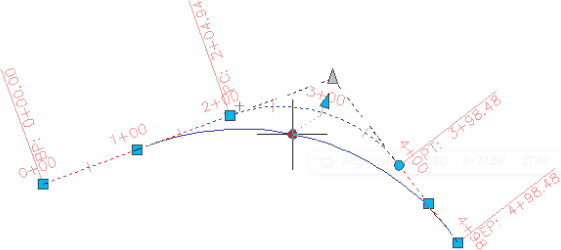
![]()

![]()

![]()

![]()
![]()
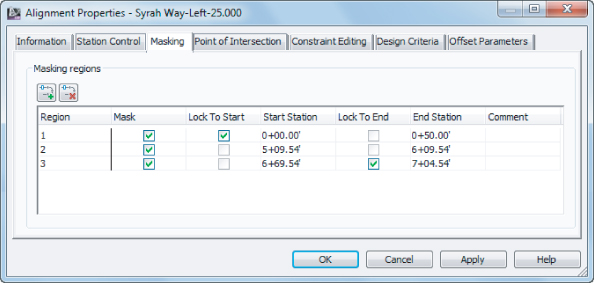
![]()
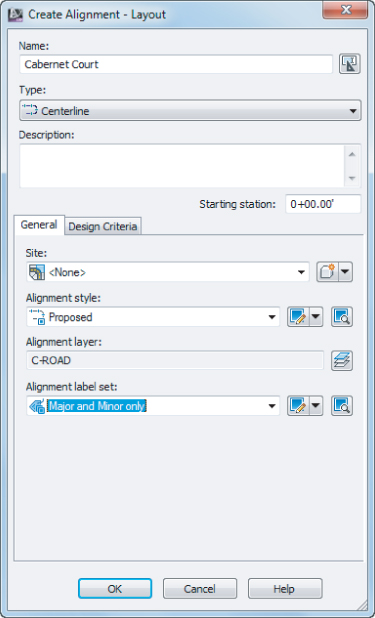




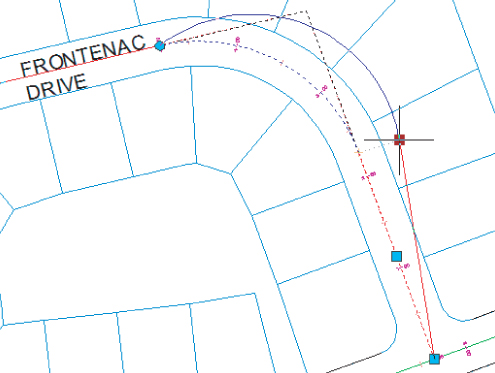
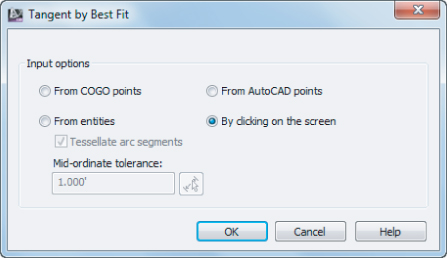

![]()

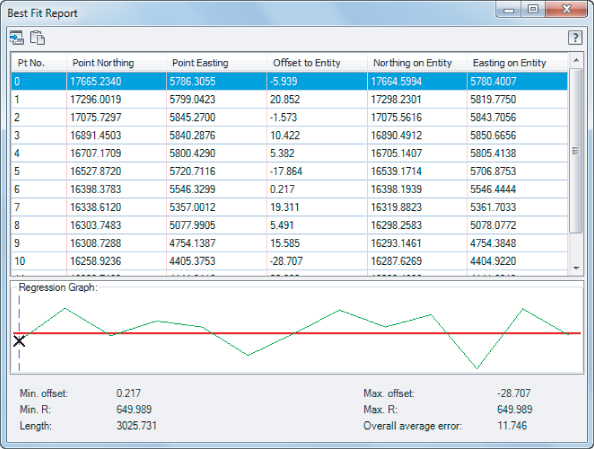

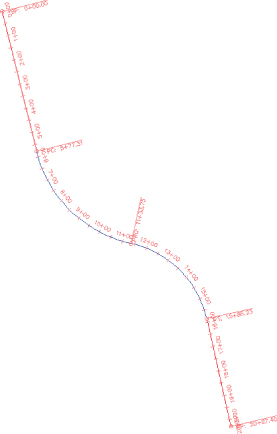
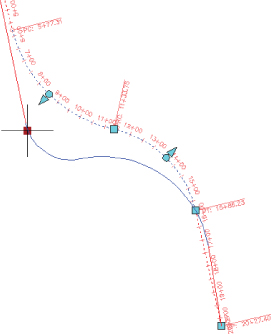
![]()
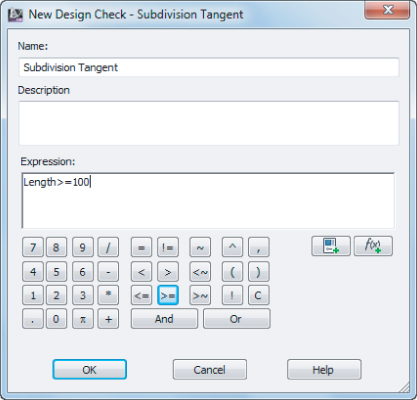
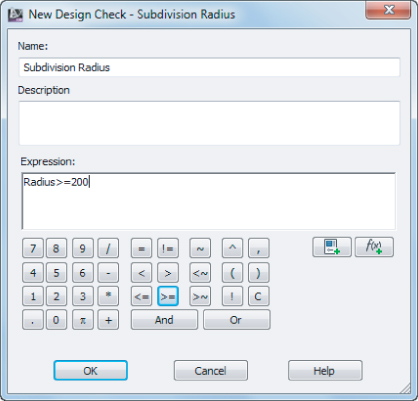
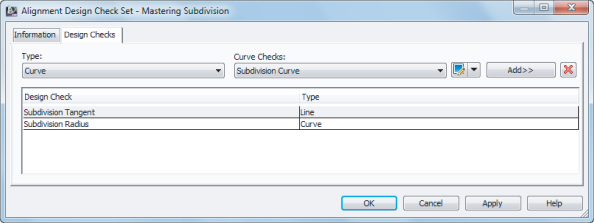
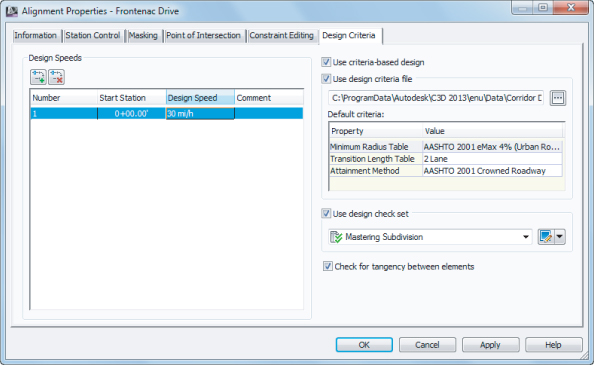

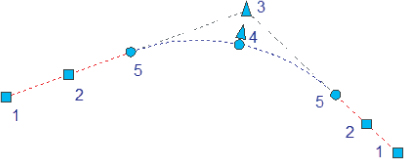

![]()

![]()
![]()
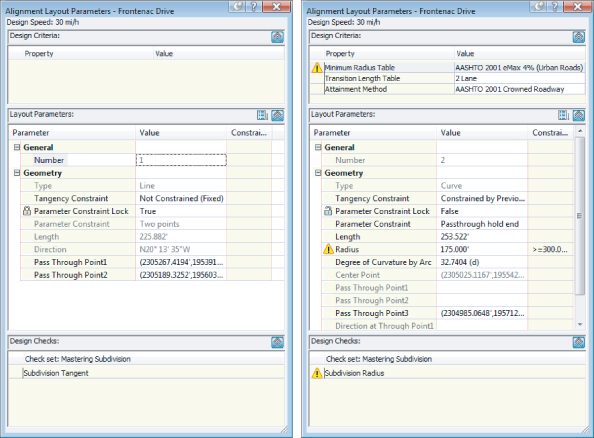
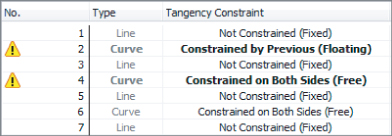


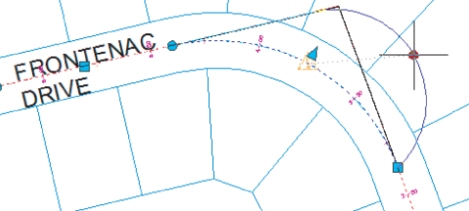
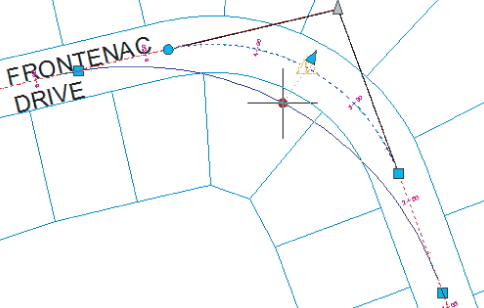


![]()
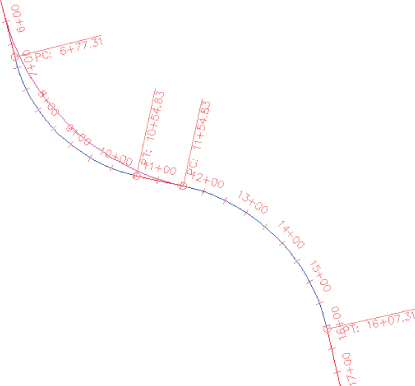

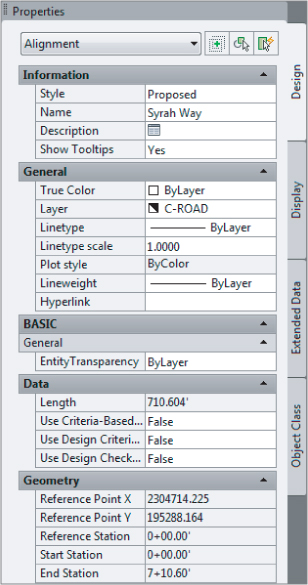

![]()
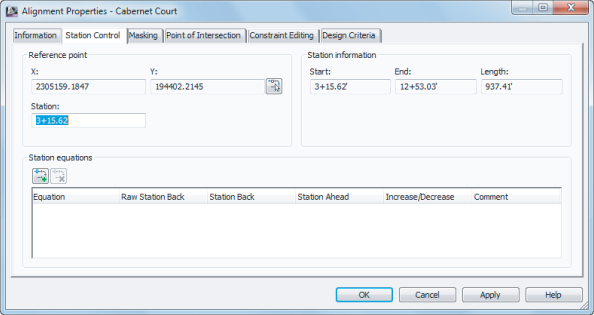
![]()
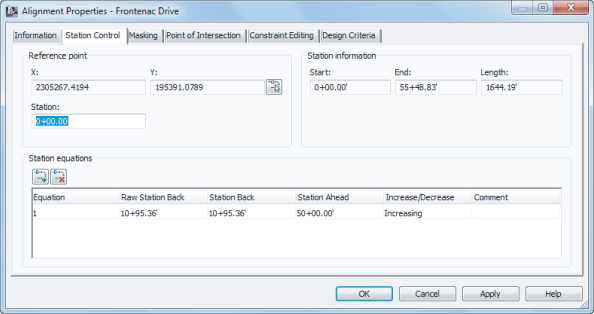
![]()
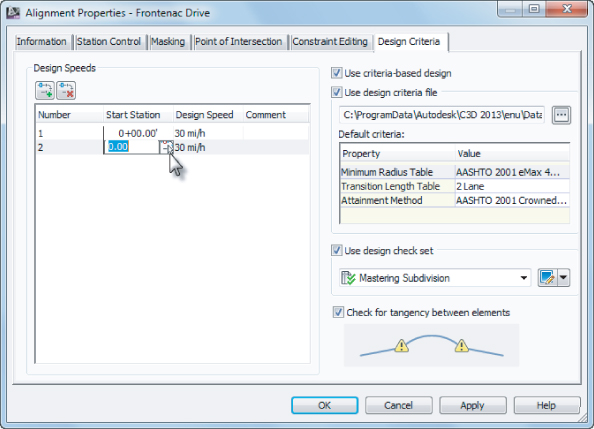
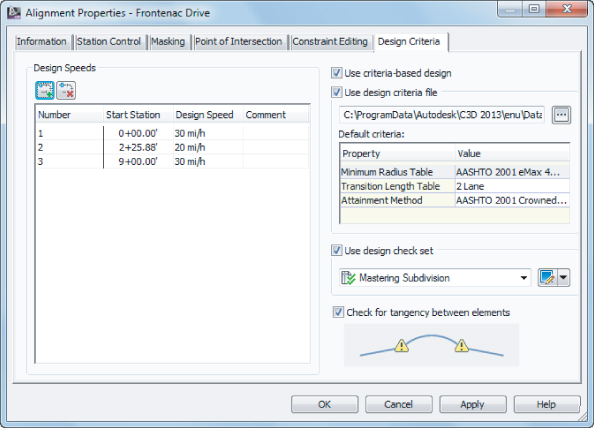
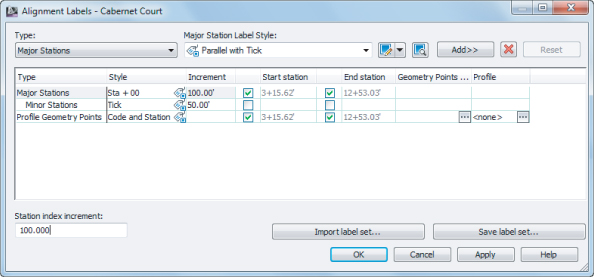

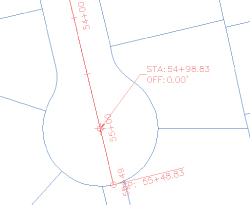
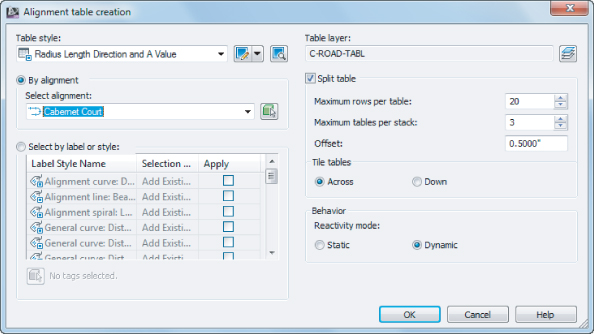
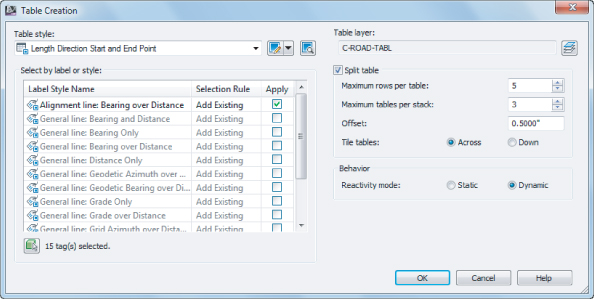
![]()

